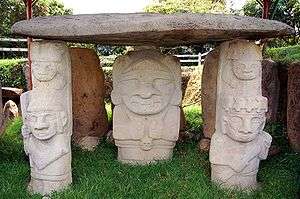San Agustín Archaeological Park
| UNESCO World Heritage site | |
|---|---|
 A tomb platform with supporting statues | |
| Location | San Agustín, Huila Department, Colombia |
| Includes |
|
| Criteria | Cultural: (iii) |
| Reference | 744 |
| Inscription | 1995 (19th Session) |
| Coordinates | 1°55′N 76°14′W / 1.917°N 76.233°WCoordinates: 1°55′N 76°14′W / 1.917°N 76.233°W |
 Location of San Agustín Archaeological Park in Colombia | |

The San Agustín Archaeological Park (Spanish: Parque Arqueológico de San Agustín) is an archaeological site located near the town of San Agustín in Huila Department in Colombia. The site contains the largest collection of religious monuments and megalithic sculptures in Latin America and is considered the world's largest necropolis. It was declared a UNESCO World Heritage Site in 1995.[1][2]
History
The statues were first described by a Spanish monk, Fray Juan de Santa Gertrudis (1724–1799), who visited the countries of Colombia (then part of the New Kingdom of Granada), Ecuador and Peru in 1756–57 as a missionary. He passed through San Agustín in mid-1756, and wrote about the statues in his four-volume work Maravillas de la naturaleza (English: Wonders of Nature).[3][4]
Geography
The archaeological park is located in the upper basin of the Magdalena River and its primary tributaries, in the municipality of the town of San Agustin in Huila in the eastern foothills of the Colombian Massif, from which emerge the three Andean mountain ranges traversing the country from south to north in the Andean Region. San Agustín is 520 km from Bogotá. The remains of the ancient cultural groups are scattered over an area of over 50 square kilometers, on plateaus located on either side of the canyon formed by the top of the Magdalena River. The park itself corresponds to a small area with a high concentration of graves and contains more than 500 statues of unknown origin.
San Agustín Archaeological Park includes:
- The source Lavapatas.
- The plank.
- The Alto de Lavapatas.
- The Chaquira.
- The Alto de las Piedras.
- The High Idols.
In addition to the main archaeological park in San Agustín, there are two further independent sites, the Heights of the Idols (Alto de los Ídolos) and the Heights of the Stones (Alto de las Piedras), which are located in the municipality of Isnos, a few kilometers from San Agustín. The Heights of the Idols is 4 km from the town of Isnos and contains the tallest statue of all the parks, at 7 meters. The Heights of the Stones park is 7 km from Isnos includes the famous "Double I" ("Doble Yo") statue.
Statues
The statues present both antropomorphic and zoomorphic fetures (from crocodiles, bats and jaguars), having shot legs. There were found approximately 300 statues. The dates of the statues are uncertain, but they are believed to have been carved between 50–400 AD.[5] The origin of the carvers remains a mystery, as most of the site is unexcavated, and no writings have been discovered yet. They were painted in bright colors, mainly yellow, red, black and white, but today only a few of them are still colored.
The statues vary in height, the tallest being 23 feet (7.0 m) tall. They are suspected to be funereal statuary.[6] In other regions of the archaeological site where large burial mounds are located, you will see more intimidating figures such as snakes, frogs, and birds strategically place to stand guard for increased protecting during the afterlife. Statues of deities or carving on the ground, of both solar gods, males, and lunar gods, females. These figures and statues provide researchers with a little insight to what this civilization thoughts and perception of life and death are.
References
- ↑ "San Agustín Archaeological Park". UNESCO World Heritage Center. Retrieved 27 January 2015.
- ↑ Güesguán, Óscar (September 13, 2013). "'Patrimonio de la humanidad en Colombia'". El Espectador.
- ↑ Correal Urrego, Gonzalo (2013). "Las Primeras Referencias a la Cultura Arqueológica de San Agustín en el Siglo XVIII". Boletín de Historia y Antigüedades (in Spanish). Academia Colombiana de Historia. 100 (857).
- ↑ Rathbone, John Paul (1991). Ecuador, the Galapagos and Colombia. Cadogan Guides. Cadogan Books. pp. 268–269. ISBN 978-0-87106-248-2.
- ↑ Forero Bonell, Francisco (January 23, 2008). "Así se ve el parque arqueológico de San Agustín desde el cielo". El Tiempo (in Spanish).
- ↑ Cavendish, Richard; Burton, Rosemary (1991). "Valley of the Statues". Wonders of the World. AA Publishing. pp. 203–203. ISBN 0-7495-3188-6.
| Wikimedia Commons has media related to Parque Arqueológico de San Agustín. |
_16.jpg)
_12.jpg)
